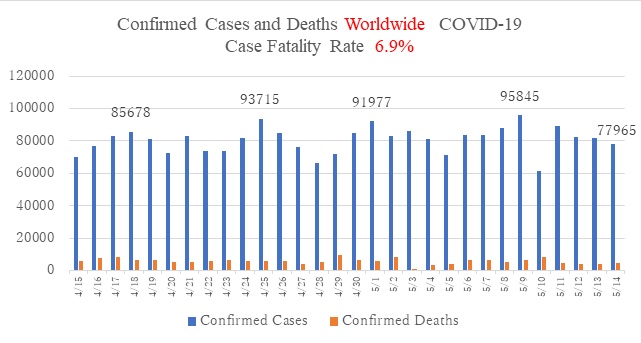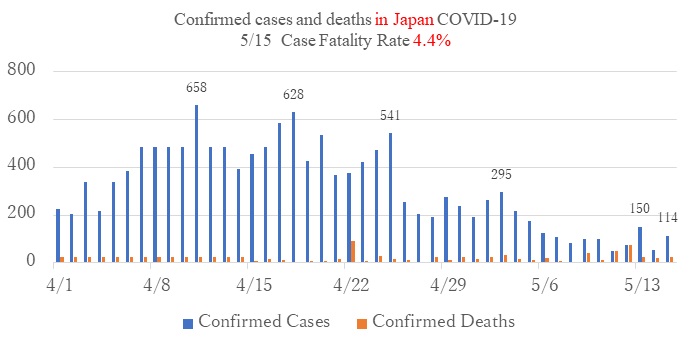SHARE
Services for the Health in Asian & African Regions (SHARE) = SHARE is a citizen sector organization (NGO) that engages in international cooperation mainly through providing health service.
HOME > News > Information of COVID-19(7)
- 【※updated】COVID-19(multi-language)
- Information of COVID-19(15)
- Information of COVID-19(vaccines)
- 《Request to the Government of Japan》Ease the protection of intellectual property rights and promote sharing and cooperating on pharmaceuticals and medical technologies, in order to accelerate efforts to overcome COVID-19 all over the world.
- Information of COVID-19(14)
- Information of COVID-19(13)
- Information of COVID-19(12)
- Information of COVID-19(11)
- SHARE Medical Information Line for Migrants is resumed in Oct.
- Information of COVID-19(10)
Information of COVID-19(7)

Information of COVID-19 (7)by SHARE 2020.05.18
1.Global and Japanese Situation of COVID-19
Confirmed cases of COVID-19 worldwide according to reports by WHO Update 2020/5/14 (Japan Standard Time) :Ministry of Health, Labor and Wellfare (MHLW)
- Globally, the number of daily confirmed cases continues in the 70,000s.
- In Europe, while the number of daily confirmed cases decreased in Italy, France, and Germany within last month; UK's daily confirmed cases continue to remain consistently high, and Russia's daily confirmed cases keep exceeding 10,000. The governments around Europe have begun gradually easing lockdown restrictions. However, the fears of triggering a second wave of COVID-19 remains.
- In America, both the US and Canada, the number of daily confirmed cases continues to rise, although the rate of increase has lessened. In Brazil, Peru, and Chile, the rate of increase is growing and has reached a critical stage.
- In Asia (western pacific region, southeast Asian region), the rate of increase is slowing. No new confirmed cases have been reported in Laos, Vietnam, and Cambodia in the last two weeks. The number of daily confirmed cases in Indonesia and Singapore continues.
Tokyo 2020/5/15(Japan Standard Time): MOHLW, Japan

Tokyo 2020/5/15(Japan Standard Time):Tokyo Prefecture Report

- The number of daily confirmed cases is decreasing nationwide as well as in the Tokyo metropolitan area.
- On May 14th, the Japanese government lifed the state of emergency in 37 prefectures, also planning to include 8 prefectures on May 22nd.
- In Tohoku, Chugoku, Shikoku, Kyusyu areas, very few new cases have been confirmed.
- In Hokkaido, Tokyo, Chiba, Kanagawa prefectures, and Hokuriku area (Nigata, Ishikawa, Toyama), the number of daily confirmed cases either increases or continues at the same rate. Reference:
https://www.japantimes.co.jp/news/2020/05/14/national/japan-coronavirus-emergency-39-prefectures/#.XsGq1C2KWu4
2.Is the Japan Model effective as a strategy?
- The Japanese government's strategy to combat COVID-19 is different from that of China and some western countries who have imposed a lockdown to limit human movement forcibly.
- The number of new, confirmed cases and deaths is comparatively smaller in Japan. This strategy has been working quite well to contain the epidemic to date.
- The Japan model allows for a certain level of economic activity and maintains people's freedom to move about in their communities. This could prove to be a more sustainable measure over the long term than more burdensome models such as lockdowns.
- The cluster-based approach, which is the basis of Japan Model, had been taken to combat the Ebola endemic; identify the cluster, isolate the individuals involved, and monitor their close contacts. The cluster-based approach to combat COVID-19 is derived from a hypothesis obtained from an epidemiological study based on Chinese data. This hypothesis posits that the explosive increase in infected persons is a result of the high transmissibility of certain infected individuals, which forms a cluster. This approach was taken in Hokkaido in February 2020, and adapted as a national strategy through the present.
- Another key component to the Japan model is the social distancing method known as "the three Cs": closed spaces with poor ventilation, crowded places with many people nearby, and close-contact settings such as close-range conversations. The declaration of a state of emergency made it possible to avoid these three Cs. As a result, overcrowded conditions decreased by 70% in Ginza, Shibuya, Shinjuku, and the passenger rate decreased to 30 % thus avoiding crowded commuter trains in the Tokyo metropolitan area.
- This cluster-based approach and the three Cs measure may seem weak countermeasure to the eyes of people in countries where strict lockdowns have been adopted. However, this approach has not been practiced overnight. Trained public health nurses at local health centers are backbones of the cluster-based approach team. Those public health nurses who are familiar with their community have been working to identify the source of the cluster and blocking the route of infection.
- Enhancing the Japan model are factors such as the habit of wearing masks. This habit is widespread in Japan and without any social stigma, making the possibility of contraction by droplet comparatively small. Behavior like shaking hands, hugging and kissing, and other forms of physical contact are not part of traditional Japanese greetings.
- Japanese countermeasures have been criticized for their low testing rates. The Japan Model focuses on decreasing the fatality case through the treatment of severe cases and not the mild cases. Therefore, PCR testing is limited to patients with a possible risk of worsening. Due to time-consuming and lack of lab technicians, PCR testing still counts less than 10,000 daily testing. The Ministry of Health, Labour, and Welfare is expecting that rapid testing will soon be able to increase the total testing within the limits of time and human resources. However, increased testing is not the MHLW's priority according to their strategy. Even in western countries, the testing of mild cases has not been a priority because of a large number of patients.
Reference:
・https://www.japantimes.co.jp/opinion/2020/04/28/commentary/japan-commentary/covid-19-strategy-japan-model/#.Xrm-22j7Rhg
・https://www.japantimes.co.jp/news/2020/05/09/national/japan-criticism-relaxes-coronavirus-testing-guidelines/#.XsBs4i2KX_Q
・https://jeaweb.jp/covid/links/guide_0421.pdf
Written by Nakasa T, MD, Co-President of SHARE
Koto K, RN, SHARE advisor
Koto K, RN, SHARE advisor
■English Information
-
Information of COVID-19(1)(ENGLISH)
-
Information of COVID-19(2)(ENGLISH)
-
Information of COVID-19(3)(ENGLISH)
-
Information of COVID-19(4)(ENGLISH)
-
Information of COVID-19(5)(ENGLISH)
-
Information of COVID-19(6)(ENGLISH)
-
Information of COVID-19(7)(ENGLISH)
-
Information of COVID-19(8)(ENGLISH)
-
Information of COVID-19(9)(ENGLISH)
■Useful URLs by multi-languages




